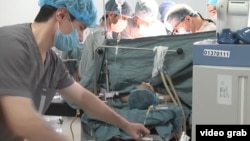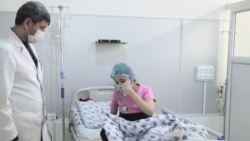DUSHANBE -- Talk about the importance of first impressions.
Two Tajik patients and their mothers are recovering from potentially lifesaving operations after being brought together by doctors at the National Scientific Center for Human Organs and Tissue Transplantation in Dushanbe.
The mothers, Rukhshona Ahmadova and Zarnigor Sangova, were cautiously introduced last month.
They hit it off immediately. They had to.
Both were engaged in desperate searches for possible organ donors for their 10- and 9-year-old daughters, respectively, when doctors told them they were a match.
Not for their own daughters, but for each other's.
"My daughter and I have lived in pain for five years," Ahmadova tells RFE/RL's Tajik Service. "My daughter was almost lost."
They had to proceed carefully after that January 15 meeting, however.
Tajikistan still has no official system for taking organs from the recently deceased, and the law only allows living-donor organ and tissue donations by family members.
Match Found
No matches had turned up from among the younger Ahmadova's three siblings or other relatives in the five years since her diagnosis.
Sangova's daughter had been diagnosed more recently but faced the same problem.
But just two weeks later -- thanks to mutual agreement and a waiver from a local medical commission -- all were recovering from dual transplantations at the nine-year-old medical facility in Dushanbe on January 31.
Ahmadova, 39, now calls Sangova, 32, her "sister."
"I gave some of my liver to her daughter, and she gave some of hers to my daughter," she says.
Their daughters, whom RFE/RL is not naming for privacy reasons, are said to be recovering well.
Diseases of the liver are a leading cause of death around the world.
They can be caused by viral infections (Hepatitis A, B, and C), toxins like drugs, alcohol, or poisons (cirrhosis and fatty liver disease), or can be inherited (Wilson disease or hemochromatosis).
The liver, which helps digest food, store energy, and eliminate poisons, is the largest organ in the human body.
Living-donor liver transplants -- in which as much as half a liver is taken from the donor -- are far less common than deceased-donor ones, but medical advances and the regenerative properties of the liver make living-donor transplants an increasingly promising option.
A healthy section of a liver transplanted to replace a diseased one can grow to full size in the patient in less than two months. A healthy donor who loses up to around 60 percent of their liver can expect it to return to full size in about the same amount of time.
Risks, Complications
Risks and complications can include rejection of the new liver by the recipient's immune system, infection, or the failure of the donated liver.
"We consulted each other and agreed. We passed the commission [hearing], and agreed," Sangova says. "Then the surgery was performed, and now I feel the same toward this woman's daughter as I do toward my own daughter."
The National Scientific Center for Human Organs and Tissue Transplantation in Dushanbe has carried out hundreds of kidney and other organ transplants since it opened in 2011.
In addition to patients from nearby Central Asian republics Kyrgyzstan, Uzbekistan, and Turkmenistan, it has also implanted organs in patients from Israel, Azerbaijan, Russia, and Afghanistan.
The overwhelming majority of its transplants are of kidneys, but in 2018 the center heralded a growing number of liver transplants.
"Nowadays in the Republic of Tajikistan, there is a real opportunity to provide...high-tech medical assistance in the form of liver transplantation to patients who were previously doomed to severe disability and imminent death," Sitorabonu Gulshanova, from the center's department of liver transplants, wrote in the official journal of The Transplantation Society in 2018.
The center carried out "more than 50" liver transplants between 2014 and 2017. The number was 17 last year, officials said, including on an infant who weighed under 5 kilograms.
Doctors there ascribe a rapid increase in the number of operations after 2015 to increased public confidence in the center -- which has made at least two mothers and their young daughters grateful.














